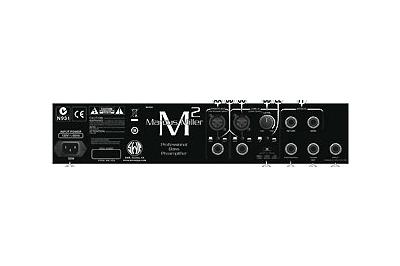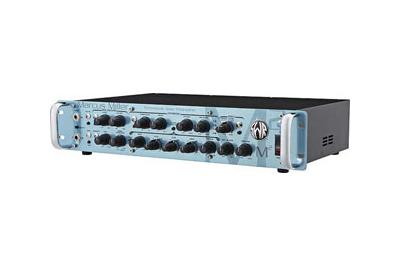Marcus Miller is one of today's heavy weights in the bass world. Not just an accomplished bassist with a personal style and groove to spare, he is also an excellent clarinetist and producer. From the beginning, Miller has taken great care to have an excellent sound out of his bass. He took his loved '77 Jazz Bass in the early 80's to Roger Sadowsky to have an onboard 2 band EQ installed, and that became his trademark sound.
As Marcus puts it, in those days you didnt't have the time to find a good sound in the studio, so produces appreciated the fact that he got an excellent sound ut of his modified Jazz Bass every time.
Marcus Miller used SWR for years, then switched to EBS and then back to SWR. SWR took this chance to codesign the ultimate bass preamp with Marcus Miller's aid, and this is the result.
Marcus Miller wanted to make sure that his signature preamp would have all the tools a pro bass player might ever need in the studio, so no corners were cut in order to achieve it.
The specs at a glance:
- Dual 12AX7A preamp valves. These are used for the Preamp, EQ, Compression and DI.
- Dual input for two basses, switchable, plus one more at the back for wireless units.
- Wide range input Gain plus pad to handle all types of bass signals.
- Mute Switch for silent tuning or just silence.
- Bass Intensifier Circuit
- Miller modified Aural Enhacer circuit.
- Full featured studio quality Compressor with Thershold, Ratio, Attack & Release controls plus Pre/Post EQ position (smart!)
- Comprehensive EQ section (bupassable): Bass & Treble plus semiparametric Low, Mid and High.
- Adjustable and switchable Boost with specific Compressor Send control
- Valve driven Balanced DI
- 4 way switch included for: EQ On/Off, Bass Intensifier On/Off, Effects Loop On/Off & Bosst On/off

Testing this preamp reveals that this is not just a nice tricks box with bells and whistles. Every pot does what it is supposed to do. A subtle change in the EQ makes an instant impact. Great! The Pre/Post EQ switch in the Compressor also makes a great sonic difference. This swith is present in many expensive outboard tube compressors, but it doesn't have the same effect as on this SWR.
The Compressor itself is worth the price of the whole unit. Some famous external preamps can hardly handle the attack of a bass, but the SWR does this job admirably, and you can go from a soft setting that will just balance those peaks to an extreme setting where the bass is somewhat "squeezed" but still musical. When coupled with the Bass Intensifier you get a full bodied sound that will sit perfectly in any mix.
Here you can see a clip of Marcus explaining himself some of the features of this preamp:
And here's Marcus having a ball himself:
This is Marcus' current live rig:

Some more details:
The Aural Enhancer is a passive R/C network that alters the frequency response throughout the bass spectrum. This pre-shaping is "blended" into the original signal through the Aural Enhancer Control. Exact frequencies affected are dependent on the characteristics of the instrument used. Basically a tone shaping control, the Aural Enhancer was developed to bring out the fundamental low notes of the bass guitar, to reduce certain frequencies that help mask the fundamentals and to enhance the high-end transients.
The Aural Enhancer has been a feature on nearly every SWR amplifier since the company's inception in 1984, and is a trademark part of the "SWR Sound" people have come to know and love. It was developed to help bring out the fundamental low notes of the bass guitar, to enhance high-end transients and to reduce certain frequencies that help mask the fundamentals. The result is a more transparent sound, especially noticeable when slapping and popping, and it can give a passive bass an "active" quality when set at two o'clock" or higher.
The Aural Enhancer works as a variable tone curve that changes depending on how you set it. As you increase the control clockwise from the "MIN" position, you're elevating a whole range of sound (lows, mids and highs) at a variety of frequency points selected specifically because they're different than those selected for the individual tone controls.
This remains true up to about the two o'clock position. This position—a favorite for many users—brings out the low-end fundamentals and crisp highs. At the same time, it adds a little lower midrange to help cut through the band. If you go further clockwise past the two o'clock position, however, selected mids will start to drop off; specifically, a group of frequencies centered around 200Hz. At this point and beyond, the effect becomes much more pronounced, but the curves involved here are gentle as opposed to the extreme curves you can create by boosting or cutting the active tone controls (EQ).
Most significantly for basses, the Aural Enhancer will help bring out the fundamentals of your lower registers without masking them with overtones, as is possible when using the Bass control only. It also opens up the sibilance characteristics of all instruments without being harsh.
Obviously, numbers and curves and circuits mean nothing compared to what you hear with your own ears. Play a chord, a repeated lick or a harmonic, and adjust the Aural Enhancer to various points to hear the effect for yourself. As always, your ears are the best judge when it comes to settings that affect the tone of your instrument.
The Bass Intensifier is a proprietary feature on many SWR amplifiers designed after 2003; the Bass Intensifier is a low-end boost circuit combined with a smooth, fast-acting compressor. The Bass Intensifier provides radical low frequency boost without overdriving the amplifier, which can be useful for heavier sections of a song - or just for "fattening up" the overall tone of your bas
The Volume Boost is cleverly designed. Not only it allows you to set the amount of boost and activate it with the inlcuded footswitch, but it also has a Compressor Send control, so you can set more compression for your boosted sound and avoid any unnecesary peaks. Neat!
The mytical SWR tube driven DI output is something sound engineers will love. It is present in XLR and Jack outpus, and comes with all the usual controls such as Level, Groudn Lift, Pre/post EQ switch, but also has a couple of extras such as phase inversion and Compression On/Off through the DI.
The main outout to the Power Amp comes in XLR and Jack so hooking this preamp to your amp will be a breeze.
You can use this preamp:
- To record in the studio
- To set up a great live rig with a good Power Amp (check your cabs for power and impedance requirements).
- Add it to your current rig. If your head has a "Power Amp In" jack, you can use the SWR preamp to dirve the amp, bypassing the head's preamp section. This is a great way to give a new life to a head that thas enough power but has a sound that you't realy like. Alternatively, you might connect the SWR preamp to the "Effects Return" jack if your head lacks the Power Amp In facility.
The fact that Marcus Miller has designed this unit doesn't mean it will just offer a great Miller sound. This it does easily (just try any good Jazz Bass and you'll see). Miller made sure that this would be a great preamp regardless of your style and bass.
To sum up: the ultimate bass preamp in sound, features and quality.









